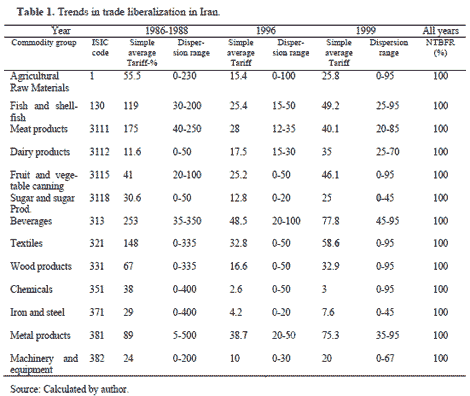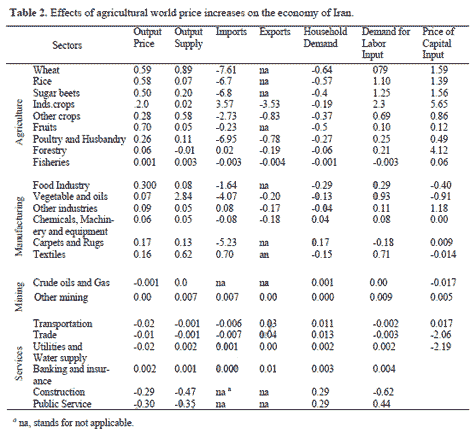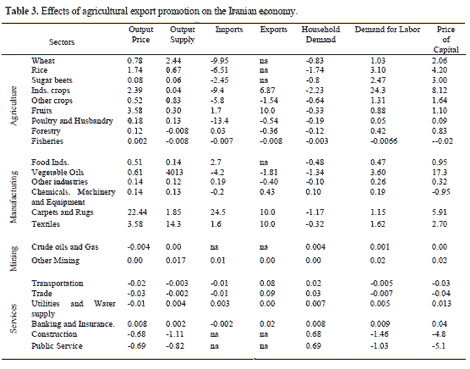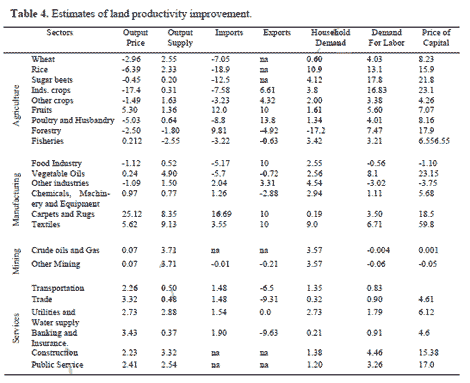کار تحقیقی حقوق تجارت بین الملل
گردآورنده محمد سالاریکار تحقیقی حقوق تجارت بین الملل
گردآورنده محمد سالاریAgricultural Land Productivity Improvement and Trade Liberalizat
J. Agric. Sci. Technol. (2006) Vol. 8: 93-106
Agricultural Land Productivity Improvement and Trade Liberalization in Iran: A CGE Analysis
H. Salami1
ABSTRACT
This paper examines the effects of agricultural land productivity improvement on the economy of Iran assuming that the domestic and international trade liberalizations will open up the opportunities to expand market access. A 25-sector computable general equilibrium model was developed to simulate the effects of this policy. The simulation results indicate that enhancing agricultural land productivity while implementing trade policy reform results in an expansion of agricultural sector which, in turn, leads to the expansion of food manufacturing and service sectors and mitigating the problem of unemployment. Furthermore, improving land productivity results in a decrease in the price of food products and an increase in real GDP. Consequently, food security enhances and Iranian welfareimproves. As a result, this is an appropriate domestic policy for Iran. This policy resultsin an expansion of agricultural sector which in turn leads to expansion of food manufacturing and service sectors, mitigates the unemployment problem, improves the Iranian welfare as the real GDP increases, and improves the food security in Iran, as the price offood products decreases.Keywords: CGE, Land productivity, Trade liberalization, Iran.
Global agricultural trade liberalization has accelerated since the Uruguay Round
Agreements (URA) on agriculture have been implemented. The agreements required WTO members to gradually reduce domestic government support, remove export subsidies, and ease barriers to the market access relative to the respective levels of Aggregate Measures of Support (AMS) estimated for the base period of 1986-1988. While the reduced trade distortions in the major supplying nations have opened up opportunities for developing countries to reap the benefits embodied in international trade, it has raised concerns that the implementation of the agreements will adversely affect these countries. These concerns are more serious among the net-importing countries and those that have not succeeded in revising their domestic trade regulations and policies in accordance with WTO requirements. As Amjadi and Yeats (1995) asserted, some URA effects on agriculture could be adverse, unless appropriate domestic policies are adopted. They argued that reforms to ensure that prices paid to domestic producers increase in line with international prices and that the removal of domestic constraints that prevent local producers from taking full advantage of new export opportunities are among the essential trade policies to mitigate the perceived adverse effects of the UR agreements. Furthermore, one of the basic tenets of economics is that a liberal international trade regime leads to a more efficient allocation of resources and a higher level of economic well being as compared with a regime that involves artificial trade distortions. Thomas and Nash (1991) summarize a number of studies that indicate the efficiency gains from trade reform ranging from 1 to 2 percent of GDP per year up to as much as 10 percent of GDP if production is

characterized by increasing returns to scale. Also, Rutherford and Tarr (1998) cited studies that reported even larger direct gains from trade liberalization. In addition, the advancement of factor productivities is considered to be an effective factor in export promotion and to further the benefits of national and international trade liberalization. The main purpose of this paper is to examine effects of agricultural land productivity improvement on the economy of Iran when domestic and international trade liberalization open up opportunities to expand access to the international markets. The interest to consider this policy arises from the fact that this option is legitimate under the WTO regulation. Thus, it can be taken as a good alternative for the current direct subsidy payment, which is prohibited under the same regulations. To evaluate the effects of this policy, the impact of continuing the current trade regime which is characterized by high level of protection and distortion and nonmembership of WTO, was investigated, while it is assumed that the increased world agricultural prices are received by domestic producers. Also, an attempt is made to analyse the consequences of some export promotion measures in selected agricultural and the related manufacturing commodities. The improvement of land productivity and promotion of exports of agricultural commodities may have implications for other sectors of the economy of Iran. Accordingly, a computable general equilibrium (CGE) model is used as the analytical framework for this study. This approach is chosen as CGE models have the ability to incorporate inter-sectoral linkages and account for both the direct and indirect impacts of policy shocks on the economy of Iran.
METHODOLOGY
Trade Distortions in Iran
The process of economic adjustment in Iran, aiming to accelerate economic growth, was initiated with the beginning of the First Five-Year Development Plan (FFYDP) in 1988. Liberalizing the trade regime and exchange system has been at the heart of the adjustment processes. The process of trade liberalization in Iran began with lowering the level of tariffs and reducing non-tariff barriers. Table 1 reports change in the levels of tariff, as a measure of trade liberalization, for major groups of commodities over the years 1986-88, 1996, and 1999. As indicated, the simple average rate of tariff for most of the commodities including agricultural raw materials, fish and shellfish, beverages, textiles, wood products, chemicals, iron and steel, has fallen by more than 50 percent from 1988 to 1999. Except for dairy products, the other commodities in the table have also experienced a reduction in the level of tariffs. Moreover, a substantial reduction in the maximum tariff rate of the commodity groups, as indicated in the dispersion ranges, can be noticed from the table. The Non-Tariff Barriers Frequency Ratio (NTBFR), as another measure of trade liberalization, is reported in Table 1. According to this measure, there is no single commodity group, which can be imported to Iran without requiring an import licence. Although the percent of NTBFR has not changed over the period 1988-1999, to ease the process of imports, the number of licences and permits required for importing the commodities has been substantially reduced (see Salami, 1998). Despite the afore mentioned reduction of tariff and non-tariff barriers, Iran’s accession to the WTO and consequent access to world markets would require the eventual elimination or further eradication of many distorting policies in trade, production, and consumption of agricultural commodities, which are inconsistent with WTO principles. Reducing domestic and trade distortions would realign production costs to relative world prices, which will result in a reallocation of resources among the competing production sectors in Iran.
Model Specification
The economy of Iran is divided into 25 sectors: 10 agricultural, 2 mining, 6 manufacturing, and 7 service sectors. In the agricultural sector, wheat and wheat products, rice, oil seeds (industrial crops), and sugar (sugar beets), which constitute the major agricultural imports, are considered as separate production sectors. This specification provides a basis for simulating the effects of world price increases of agricultural products, resulting from URA, on the Iranian economy. In Iran, horticulture and fisheries are regarded as major exporting sectors. Accordingly, in the present CGE, each of them is formulated as a separate sector. In addition, animal husbandry which provides import- substituting products is another important production sector. The mining sector consists of two main sub-sectors; crude oil and natural gas, and minerals. These two sectors are mainly responsible for providing the foreign currency required for operating and developing the other economic sectors in Iran. In the manufacturing sector, food industries excluding edible oil, textiles and leather industries, carpet and rug industries, agricultural machinery and equipment, and chemical industries are separated from all other industries. This specification can provide clear linkages between the agriculture and the related forward and backward industries. Furthermore, the “carpet and rug” industry is a major export-contributing sector, while the edible oil industry is a heavily imports- based sector. In addition, the food, textile and leather industries have considerable potential for export promotion given that implementation of the URA will expand opportunities to access markets. Therefore, the above specification can easily accommodate various policy simulations. In the service sector, utilities and water supply, banking and insurance, trade, transportation, construction, and all public services are considered as separate sectors. It is assumed that all specified sectors, except the two public services, and the construction service sectors, are trading sectors. They import from the rest of the world, and produce and supply goods and services to both domestic and foreign markets. The last three sectors are non-trading in the sense that they supply their services completely to the domestic market. The Armington assumption, which treats domestic and imported goods as imperfect substitutes, is used for modeling trade in the present CGE model (Armington, 1969). This assumption is adopted to take into account a two-way trade and to avoid an unrealistically high degree of specialization. It is assumed that imported and domestically produced commodities are aggregated into new composite commodities based on a constant return to scale CES function. The composite commodities are used as inputs in the production sectors, and are consumed as final goods by government and one representative private household. The cost minimization assumption applied to the CES production function results in the import demand function where the levels of imports depend on the ratio between domestic and foreign market prices and the degree of substitutability between domestic and foreign commodities. Exports are also specified as a function of changes in the relative prices of domestic and foreign markets. A small country assumption is used in specifying all sectors’ imports and exports, except for those of the mining, horticulture, and wheat sectors. Mining and horticulture exports are modeled with an assumption that Iran has some market power in the international markets. This suggests that Iranian crude oil and fruit exports face a downward sloping excess demand curve from rest of the world importers. Furthermore, as Iran is a major wheat importing country, it is assumed that Iran has some market power in the international wheat market. The CGE model developed in this study, like most models of the ORANI type (Dixon et al., 1982; Dixon et al., 1992), assumes that, at the first level, primary and intermediate inputs are combined in fixed proportion to produce each unit of output. At the second level, the primary factor inputs are combined using CES technology to make GDP. At this level, substitution is made possible only among primary factor inputs. The primary factor inputs include labor, capital, and land. It is assumed that labor is used in all sectors and fixed in supply within the country but mobile among sectors. On the other hand, capital input is assumed to be sector-specific and fixed in supply. Land input is assumed to be used only in the agricultural sectors and is fixed in supply. International migration of labor and adjustments to the capital stock in response to shocks in the economy are not permitted. These long run adjustments of labor supply and investment may obscure the short run impacts of shocks in the agricultural sector. Furthermore, the model assumes wage rigidity in the labor market. In this specification, the labor market clears through adjustments in the unemployed labor force. Since capital is sector specific, its rental rates, which are endogenous to the model, will adjust to clear the market for capital input. The same argument holds for land input in the agricultural sector. Cost minimization yields the demand functions for the primary inputs in each of the industries. Intermediate demands are determined by fixed coefficients. In the present model, there is one representative private household that consumes commodities and supplies the primary factors of production. The household income is formed by primary factor rewards. The household demands for commodities are derived from maximization of a Cobb- Douglas utility function subject to its income corrected for taxes. The same argument holds for deriving government consumption demand for commodities. The complete algebraic model is presented in Appendix 1. The definitions of variables used in the model are shown in Appendix 2 while the parameters of the model are given in Appendix 3. The model is short-run in nature. In this scenario, the markets for factor inputs respond to policy shocks through price changes while, in the long run, the adjustments are mainly through quantity changes. The model is not closed in the sense that neither the changes in exports equal the change in imports nor the changes in savings equal the change in investments. Since capital stock is fixed, there are no changes in investment. Consequently, it is assumed that there are no savings. The exchange rate is also assumed to be fixed and the balance of payments adjusts any change in the trade balance. Following Johansen (1960), the model is specified in the form of proportional rates of change in which variables are specified in a system of linear equations. In order to account for linearizing errors associated with Johansen’s approach, a multi-step solution was obtained using the GEMPACK program. (See Hertel et al. 1992, for details on errors associated with linearized models.) The main sources of data are: a) The input-output table for 1991 (Iran Statistical Center, 1994); b) The National Accounts data for 1991 published by the Central Bank of the Islamic Republic of Iran; c) The data on factor elasticities of substitution in the agricultural sectors are taken from Salami (1996); d) The values for other parameters are adopted from drawing heavily on the literature. (Sadoulet and deJanvry1991, is the main reference for export demand elasticities.) To investigate the effects of land productivity enhancing policy, three different policy measures are simulated. 1) Continuing the present trade regime which is characterized by a highly protected and distorted regime and a non-membership of WTO, while opening up the domestic market to price signals in the world market. In this scenario, the world prices of major agricultural products such as wheat, rice, sugar beets, industrial crops, fruits, and vegetable oils are assumed to increase by 4 to 10 percent as predicted by FAO(1995), Goldin and van der Mensbbrugghe (1995), and Brando and Martin (1993). 2) Allowing local producers to take full advantage of new exports opportunities and, thus, expand exports of fruits (including nuts), carpets and rugs, and textiles by 10 percents, while leaving other policies unchanged. 3) Reducing public expenditure on production subsidies by 20 percent and increasing the expenditure to raise the land productivity by 10 percent, while taking advantage of new exports opportunities
.
RSULTS AND DISCUSSION
The impacts of land productivity improvement on the agricultural sector on the economy of Iran are analyzed within three different scenarios. Specifically, the effects on domestic production, prices, imports, exports, household demand and expenditure, employment, GDP, and inflation are investigated and analyzed.
Scenario I
Table 2 reports simulation results of an increase in world prices of the specified commodities on the economy of Iran. According to this scenario, transmission of increased world prices for the aforementioned agricultural products to the domestic market results directly in an increase in prices of substituting products and indirectly in an increase in the product prices of poultry and husbandry. This induces the expansion of domestic production in all agricultural sectors, except for the forestry sector. The output response to the price increases is not the same in all sectors. Wheat shows the highest degree of responsiveness (0.9 %) while the industrial crop sector reveals the lowest one (0.02 %). The rise in agricultural sector outputs and

the decline in demand for agricultural commodities as a result of price increases, reduce the need for importing agricultural commodities. The import reduction is 7.61 percent for wheat, 6.7 percent for rice, 6.8 percent for sugar beets, 3.57 percent for industrial crops, 6.95 percent for meat products, and 0.23 percent for fruits. The increased agricultural output prices will also increase the cost of production in the sectors using agricultural products as inputs. This results in a 0.3 percent increase in the prices of food industry products, 0.07 percent in the prices of vegetable oils, 0.16 percent in the prices of textiles, and 0.17 percent in prices of carpets and rugs. This in turn causes a reduction in household demand for these commodities. On the other hand, expansion in the agricultural sectors leads to an increase in demand for the primary inputs (labor, land, and capital) used in these sectors, the products of support industries (namely, machinery, equipment, and chemical products), and the demand for credits and insurance services. Among the macroeconomic variables, a rise of 0.9 percent in the consumer price index is noticed as a result of increases in the prices of most agricultural and nonagricultural products. A small reduction in GDP by 0.03 percent is shown as a contraction in the service sectors, which has a share of almost 40 percent in Iranian GDP (Table 5). Furthermore, total imports increase, while total exports decrease. The slowdown in GDP growth leads to a fall in the overall level of employment. On the basis of the above results, allowing increased world agricultural prices to be transmitted to the domestic markets while leaving all other policies unchanged can generate negative effects on the overall economy of Iran, and thus it is not recommended.
Scenario II
This scenario examines the degree to which the negative effects of increased world prices of agricultural products on the economy of Iran can be offset by setting an export promotion policy. Since fruits (including nuts), carpets and rugs, and textiles are all major Iranian non-oil exporting items, it is assumed that exports of these products will be increased by 10 percent as a result of increased market access opportunity expected following URA implementation. The results of this simulation are reported in Tables 3 and 5. Table 5 reveals two noticeable points. First, export expansion of agricultural products improves GDP growth and the level of employment so that the negative effects of the first scenario from these two perspectives are mitigated. A 0.01 percent improvement in real GDP and a 0.05 percent increase in the level of employment are the immediate effects of the expansion in exports. Second, export expansion exacerbates the inflationary effects of increased world agricultural prices on the economy of Iran in the short run. This overall price increase, in

turn, causes a reduction in the real income of Iranian households from (-0.09) to (–0.14) percent.
Scenario III

improvement as an alternative policy for the current direct subsidy payment to the agricultural sectors. The investment required to advance land productivity is financed by expenditures saved from a partial removal of subsidy on agricultural inputs. In this scenario, it is specifically assumed that the expenditure saved from a 20 percent reduction in the agricultural subsidies is invested in agricultural land to increase productivity by 10 percent. The encouraging results of this scenario are presented in Tables 4 and 5. According to Table 5, growth of the real GDP (3.81%), an increase in the level of employment (2.52%), a rise in exports (2.05%), a decline in imports (-0.4.22%), and an increase in the real income of the household (2.41%) are all positive effects of implementing the above policy. These results are not surprising, since the progress in land productivity decreases the unit cost of production and increases the producers’ profits, and thus encouraging greater production of goods and services. As indicated, the enhancement in land productivity offsets the negative effects of the previously described scenarios, and results

in the aforementioned positive impacts on the economy of Iran. Therefore, one can conclude that improvement in the land productivity should be considered as an appropriate domestic policy in order to prevent the adverse effects of trade liberalization, and to reap the benefits of national and international trade liberalization.
CONCLUSION
The findings of this study are consistent with the wisdom that reducing trade distortion and expanding trades results in an improvement in overall economic efficiency and growth. The types of policies and the economic environment, however, have important implications for the other macroeconomic variables. In the context of the Iranian economy a policy package that consists of increasing land productivity, removing input subsidies, and expanding exports appears to be an appropriate policy option for increasing the supply of agricultural and nonagricultural output, improving real household income, and enhancing labour employment. In other words, the Iranian economy cannot benefit from joining the WTO unless this is accompanied by a set of policies which result in an improvement in land productivity in the agricultural sector.
REFERENCES
1. Amjadi, A. and Yeats, A. 1995. Non-tariff Barriers Africa Faces: What did the Uruguay Round Accomplish, and What Remains to Be Done? Policy Research Working Paper 1439, The World Bank, Washington D.C. 2. Armington, P. 1969. A Theory of Demand for Products Distinguished by Place of Production. International Monetary Fund Staff Papers 16: 179-201. 3. Brando, A. and Martin, W. 1993. Implications of Agricultural Liberalization for the Developing Countries. Agr. Econ., 8: 313- 343. 4. Central Bank of the Islamic Republic of Iran. 1992. National Accounts of Iran 1980-1990. 5. Dixon, P., Parmenter B., Sutton, J. and Vincent, D. 1982. ORANI: A Multi-sectoral Model of the Australian Economy. North- Holland Publishing Company, Amsterdam. 6. Dixon, P., Parmenter, B., Powell, A. A. and Wilcoxen, P. J. 1992. Notes and Problems in Applied General Equlibrium Economics. North-Holland Publishing Company, Amsterdam. 7. FAO. 1995. Impact of Uruguay Round on World Trade and Commodity Prices. Commodity and Trade Division, Food and Agriculture Organization, Italy. 8. Goldin, I. and van der Mensbrugghe, D. 1995. The Uruguay Round: An Assessment of Economy Wide and Agricultural Reforms. In: “The Uruguay Round and the Developing Economies.” (Eds.): Martin, W. and Winters, L. A. The World Bank, Washington, D.C., PP: 16-94. 9. Hertel, T. W., Horridge, J. M., and Pearson, K. R. 1992. Mending the Family Tree: A Reconciliation of the Linearization and Levels Schools of AGE Modelling. Econ. Model., October:385-407. 10. Iran Statistical Centre. 1994. Input-Output Table of Iran Economy 1986. Planning and Budgeting Organization, Tehran. Iran 11. Johansen, L. 1960. A Multi-sectoral Study of Economic Growth. North-Holland Publishing Company, Amsterdam. 12. Rutherford, T. F., and Tarr, D. G.1998. Trade Liberalization and Endogenous Growth in a Small Open Economy: A Quantitative Assessment. Paper presented to a seminar on Technology Diffusion and Developing Countries, Milan, Italy, April 1997. 13. Salami, H. 1998. Analysing the Impacts on Agricultural Sector of Iran’s Membership of WTO in a CGE Framework. Research Institute for Planning and Agricultural Economics, Ministry of Agriculture, Tehran, Iran. 14. Salami, H.1996. Production Structure and Productivity Measurement in the Iranian Crop Sector. Unpublished Ph. D. thesis, University of Alberta, Canada. 15. Sadouleth, E. and DeJanvry, D. 1991. Agricultural Trade Liberalization for the Low Income Countries: A general Equilibrium - Multi market Approach. Working Paper No. 614,Department of Agricultural and Recourse Economics, University of California, Berkeley 16. Thomas, V. and Nash, J. 1991. Best Practice in Trade Policy Reform, Oxford University Press, Oxford


























